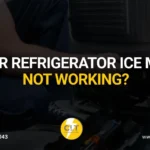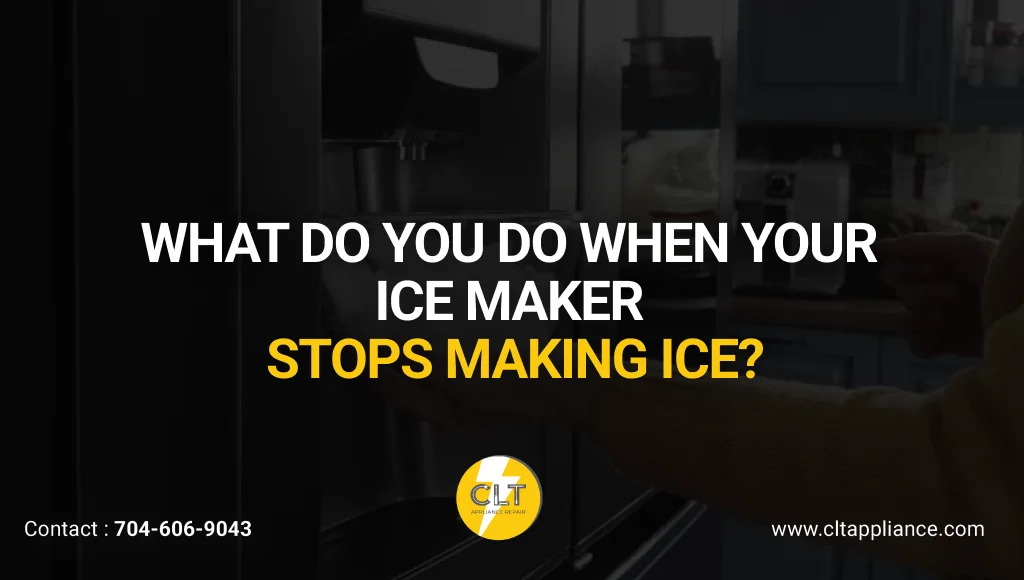[TL;DR]
Your fridge freezer needs immediate repair if you notice unusual noises, inconsistent temperatures, excessive frost buildup, water leaks, or persistent odors. Ignoring these warning signs leads to food spoilage, higher energy bills, and complete appliance failure. Regular maintenance and professional repair can save you hundreds of dollars.
Did you know that the average American household throws away $1,600 worth of food annually due to spoilage, with faulty refrigeration being a major culprit? Your fridge freezer works 24/7 to keep food fresh and safe for your family. When this essential appliance starts showing warning signs, ignoring them can lead to spoiled groceries, skyrocketing energy bills, and complete system failure that costs thousands to replace.
Recognizing early warning signs saves money and prevents food waste. Most fridge freezer problems start small but escalate quickly without proper attention. So, don’t let a minor issue turn into a major expense.
If your Freezer Needs Immediate Repair, you can contact our experts at CLT Appliance Repair for a quick diagnosis and save yourself from costly emergency replacements.
Get In Touch: 704-606-9043
The Importance of Regular Fridge Freezer Maintenance
Regular maintenance prevents 80% of appliance failures and extends your fridge freezer’s lifespan by 3-5 years. Most homeowners skip routine care until problems appear, leading to expensive repairs and premature replacement.
Extends Lifespan and Saves Money
Regular maintenance can prolong your fridge freezer’s life from 10-13 years to 15-18 years. Simple tasks like cleaning coils and checking seals prevent costly breakdowns that average $300-800 per repair.
Preventive care costs $50-100 annually but saves thousands in replacement costs. A new fridge freezer costs $800-3,000, while maintenance keeps your current unit running efficiently.
Maintains Food Safety and Energy Efficiency
Proper maintenance prevents dangerous temperature fluctuations that spoil food and create health risks. Clean coils and proper airflow keep energy usage low, reducing monthly utility bills by 15-25%.
Dirty condenser coils force the compressor to work harder, increasing energy consumption and wear. Regular cleaning maintains optimal efficiency and prevents premature component failure.
Easy Routine Tasks
Monthly maintenance takes 15-20 minutes and includes three essential tasks:
- Check door seals: Look for cracks or gaps that let cold air escape
- Clean condenser coils: Use a vacuum or brush to remove dust buildup
- Organize interior: Maintain proper airflow by avoiding overcrowding
Additional monthly tasks include:
- Wipe down shelves and remove expired items
- Check temperature settings (37°F fridge, 0°F freezer)
- Clear the drain holes of debris or food particles
- Test door alignment and closing mechanism
5 Warning Signs Your Fridge Freezer Needs Immediate Repair
Your fridge freezer works around the clock to keep your food fresh and your family safe from spoilage. Recognizing the following five critical warning signs early can save you from expensive emergency repairs, food waste, and the inconvenience of complete appliance failure.
-
Unusual Noises and Vibrations
Strange sounds from your fridge freezer indicate mechanical problems that require immediate attention. Normal operation includes quiet humming and occasional clicking, but grinding, knocking, or buzzing signals component failure that can lead to complete breakdown.
Common Problem Sounds
Your fridge freezer produces several warning sounds that indicate specific problems:
- Grinding noises: Worn compressor bearings or motor problems
- Knocking sounds: Loose components or failing fan motors
- Loud buzzing: Electrical issues or refrigerant problems
- Rattling: Loose screws, worn mounts, or debris in fan blades
- Frequent clicking: Thermostat or relay problems
- Squealing: Worn belts or fan motor issues
Normal sounds include quiet humming during operation and occasional clicking when the compressor cycles on and off.
Pro-Tip:
Record unusual sounds with your phone to help repair technicians diagnose problems more quickly and accurately.
What Noises Often Mean?
Different sounds point to specific component failures requiring targeted repairs:
- Compressor problems: Create grinding or knocking sounds, need professional repair
- Fan motor issues: Cause squealing or rattling, may affect cooling performance
- Thermostat problems: Create frequent clicking as the unit struggles to maintain the temperature
- Electrical component failure: Produces buzzing or humming when components fail
- Refrigerant leaks: Create gurgling sounds, indicating serious problems needing immediate attention
Understanding these sound patterns helps you communicate problems clearly to repair technicians and prioritize urgent repairs.
-
Inconsistent Temperatures or Poor Cooling
Temperature fluctuations compromise food safety and indicate serious system problems developing inside your appliance. When your fridge freezer struggles to maintain consistent cooling, it wastes energy and puts your groceries at risk of rapid spoilage.
Food Spoilage and Inaccurate Internal Readings
Temperature fluctuations above safe levels cause rapid food spoilage and health risks:
- Refrigerator above 40°F: Dairy products sour quickly, produce wilts faster
- Freezer above 0°F: Ice crystals form on frozen items, and texture changes occur
- Frequent temperature swings: Internal thermometers show inconsistent readings
- Hot spots: Some areas are warmer than others, uneven cooling patterns
Early warning signs include milk souring within days instead of weeks, frozen vegetables becoming soggy, and fresh herbs wilting within 24 hours of purchase.
Wake-up Call:
Restaurants lose $2,000-5,000 monthly from food spoilage due to refrigeration failures, making immediate repairs essential for food safety and profitability.
Causes
Multiple factors contribute to temperature control problems requiring different repair approaches:
- Faulty thermostats: Fail to maintain set temperatures, require professional replacement
- Compressor problems: Reduce cooling capacity, increase energy consumption significantly
- Refrigerant leaks: Cause gradual temperature increases, leading to complete system failure
- Blocked air vents: Prevent proper circulation, create hot spots in compartments
- Dirty condenser coils: Reduce heat exchange efficiency, force the system to work harder
- Door seal problems: Let warm air enter, making the compressor run constantly
Each cause requires specific diagnostic techniques and repair methods. Professional technicians use specialized tools to identify root causes accurately.
Consider scheduling a diagnostic service with CLT Appliance Repair when you notice the first signs of temperature inconsistency. Catching problems early saves both your food budget and the stress of sudden appliance failure!
-
Excessive Frost or Ice Buildup
Abnormal frost accumulation means your fridge freezer needs immediate repair to prevent permanent damage. While minimal frost is normal, thick ice buildup indicates defrost system problems or air seal failures.
Normal vs Problematic Frosting
Normal frost appears as light, thin layers that disappear during defrost cycles. Problematic frosting creates thick ice blocks, covers vents, or appears in unusual locations like door frames or fresh food compartments.
Ice blocking air vents reduces cooling efficiency and forces the compressor to run constantly. Frost on fresh food indicates severe temperature control problems requiring immediate attention.
Issues with Seals or Defrost Mechanism
Two main systems cause excessive frost when they malfunction:
Door Seal Problems:
- Worn rubber gaskets let humid air enter compartments
- Cracked seals create gaps, allowing warm air infiltration
- Loose door alignment prevents proper sealing
- Damaged magnetic strips reduce the closing force
Defrost System Failures:
- Timer malfunctions prevent automatic defrost cycles
- Heater elements burn out, stopping the ice melting process
- Temperature sensors fail, disrupting defrost timing
- Drain tubes freeze, blocking water removal
Note: Seal replacement costs $50-150 but prevents hundreds in energy waste. Defrost system repairs typically cost $200-400, but avoid $1,000+ compressor replacements.
-
Water Leaks or Excess Moisture
Puddles of water around or inside your appliance indicate drainage failures that can cause extensive property damage. Interior moisture creates health hazards through mold growth, while floor leaks damage cabinets, flooring, and create dangerous slip hazards.
Pooled Water Inside or Around the Unit
Water pooling inside compartments suggests blocked drain holes or damaged door seals. Puddles around the base indicate drain pan overflow or water line leaks requiring immediate repair.
Interior moisture causes mold growth, food contamination, and electrical hazards. Floor water damages cabinets, flooring, and creates slip hazards for family members.
Blocked Drainage, Broken Water Line, or Overfilled Pans
Three main water system problems create leaks requiring different repair approaches:
Drainage Issues:
- Blocked drain holes prevent defrost water removal
- Clogged drain tubes cause interior flooding
- Frozen drain lines stop water flow completely
- Food debris blocks drainage pathways
Water Line Problems:
- Cracked supply lines create continuous leaks
- Loose connections drip constantly
- Damaged filter housings leak during operation
- Frozen lines burst when temperatures drop
Drain Pan Issues:
- Overfilled pans overflow when evaporator fans fail
- Cracked pans leak directly onto the floor
- Misaligned pans miss drainage completely
- Clogged pan drains cause backup
Repair costs vary significantly: drain cleaning costs $75-150, water line repairs range $100-300, and pan replacement typically costs $50-100, including labor.
-
Persistent Odors or Excessive Condensation
Unusual smells emanating from your appliance signal potential health hazards requiring immediate professional attention. Chemical, burning, or musty odors indicate serious problems ranging from refrigerant leaks to electrical failures that pose safety risks to your family.
Bad Smells and What They Mean
Different odors indicate specific problems requiring immediate attention:
- Chemical odors: Refrigerant leaks pose health risks, need emergency service
- Burning smells: Electrical problems or overheating components, potential fire hazard
- Musty odors: Mold growth from excess moisture, a health and food safety concern
- Rotten egg smells: Gas leaks requiring immediate evacuation and emergency service
- Sweet chemical odors: Refrigerant problems needing professional attention within 24 hours
- Sour or spoiled odors: Food contamination or cleaning issues
Never ignore chemical or burning smells, as they indicate serious safety hazards requiring immediate professional intervention.
Condensation on Shelves or in Compartments
Excessive condensation indicates door seal problems or ventilation failures. Water droplets on shelves suggest humidity control issues or blocked air circulation. Condensation in freezer compartments indicates defrost problems.
Seal replacement prevents condensation and reduces energy costs by 20-30%. Ventilation repairs ensure proper airflow and prevent mold growth that contaminates food.
Tip:
Use a hygrometer to measure humidity levels inside your fridge. Levels above 60% indicate seal or ventilation problems requiring professional repair.
What to Do Next?
Immediate action prevents minor issues from becoming expensive replacements. Some problems require DIY solutions while others need professional expertise to avoid safety hazards or warranty violations.
When to Call a Professional vs DIY Tips
Understanding which repairs you can handle safely versus those requiring professional expertise:
Call Professionals For:
- Electrical problems and wiring issues
- Refrigerant leaks and system recharging
- Compressor replacement or major repairs
- Gas leaks require immediate emergency attention
- Warranty-covered repairs to avoid voiding coverage
Safe DIY Tasks:
- Cleaning condenser coils with a vacuum or a brush
- Replacing door seals and gaskets
- Clearing the drain holes of debris
- Adjusting door alignment and leveling
- Replacing water filters and light bulbs
Never attempt refrigerant repairs yourself due to environmental regulations and safety hazards. Professional technicians have proper tools and certifications for safe refrigerant handling.
Simple maintenance saves service calls, while complex repairs need professional expertise and specialized tools.
Routine Maintenance and Prevention
Consistent maintenance prevents common problems and significantly extends appliance life:
Monthly Tasks:
- Clean condenser coils to maintain efficiency
- Check door seals for cracks or damage
- Organize the interior for proper airflow
- Monitor temperature settings and adjust if needed
Quarterly Tasks:
- Deep clean interior shelves and compartments
- Replace water filters in applicable models
- Check drain holes and clear debris
- Test door alignment and adjust if necessary
Annual Tasks:
- Schedule a professional maintenance inspection
- Replace worn door seals and gaskets
- Clean evaporator coils behind panels
- Check electrical connections for safety
Maintain refrigerator temperature at 37°F and freezer at 0°F for optimal performance and energy efficiency.
Bottom Line
Recognizing these five warning signs saves money, prevents food waste, and extends your fridge freezer’s lifespan. Your fridge freezer breakdown doesn’t care that it’s Sunday evening or that you just bought $200 worth of groceries. When temperature alarms start beeping and frost blocks your freezer vents, you need repair experts who understand that every hour counts.
CLT Appliance Repair specializes in emergency fridge freezer repairs that save your food and your sanity. Our certified technicians carry an extensive parts inventory and arrive equipped to fix most problems on the first visit. We’ve rescued 100s of refrigerators from the appliance graveyard and helped families avoid the stress of sudden appliance replacement.
We provide transparent pricing, same-day service, and repairs that extend your appliance’s life by years rather than months. Our customers consistently tell us we’ve saved them from expensive replacement costs and the hassle of appliance shopping under pressure.
Call CLT Appliance Repair now: 704-606-9043 and get your fridge freezer running perfectly before your next grocery trip!
Frequently Asked Questions
Why is my fridge not cooling, but the freezer works?
This typically indicates a blocked air damper, a faulty evaporator fan, or a problem with the defrost system preventing cold air circulation from the freezer to the refrigerator compartment.
Is it better to repair or replace a broken fridge freezer?
Repair if the unit is under 8 years old and the repair costs less than 50% of the replacement value. Replace older units with expensive repairs.
What are the most common refrigerator and freezer problems?
Temperature control issues, door seal failures, defrost system problems, water leaks, and unusual noises account for 80% of service calls and repair needs.
Can I fix fridge freezer problems myself, or should I call a professional?
Simple tasks like cleaning coils and replacing seals are DIY-friendly. Call professionals for electrical, refrigerant, or compressor issues requiring specialized tools and expertise.
How much does it usually cost to repair a fridge freezer?
Basic repairs range $150-300, complex issues cost $300-600. Compressor replacement averages $500-800, while simple maintenance costs $75-150, including parts and labor.
Author

- John Bennett
- John Bennett is a seasoned appliance repair specialist at CLT Appliance Repair, where he brings over a decade of technical expertise and a strong commitment to customer satisfaction. With a background in electrical and mechanical systems, John has built a reputation for reliable, efficient, and honest repair services across a wide range of household appliances-including refrigerators, washing machines, ovens, and more.







